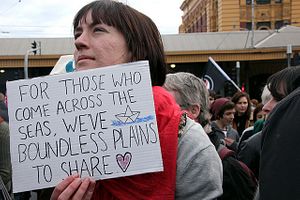This week, an Iranian couple became the latest refugees to leave Cambodia after being temporarily resettled in Phnom Penh as part of a controversial deal between Cambodia and Australia. The flight of the couple, who were among the four that volunteered as part of the original September 2014 deal, is the latest sign that it is going nowhere.
Under the deal, Cambodia agreed to take an unspecified number of refugees that Australia is holding on Nauru for an additional AU$40 million in aid. The refugees left an Australian detention center in Nauru where over 600 refugees and asylum-seekers are believed to be held. Australia in turn pledged to pay resettlement costs for a year and provide refugees who resettle to Cambodia with cash handouts, language and skills training as well as health insurance.
But since the deal was inked, only five refugees have voluntarily resettled in Cambodia on the last count. And even so, the Iranian couple, along with Rohingya man who returned to Myanmar in October last year, had voluntarily gone back to their home country for unspecified reasons, according to Sok Phal, director of Cambodia’s Interior Ministry’s immigration department this week. That essentially leaves just one person – also an Iranian man – remaining from the original group of four refugees who came to Cambodia in June last year. He is joined by a compatriot who arrived last November.
According to The Cambodia Daily, a spokesman for Australia’s Immigration Department did not comment on the couple’s departure, while the International Organization for Migration (IOM), the organization that had been helping resettle refugees in Cambodia, declined to answer questions about the refugees’ decision to return.
The departure of a majority of the original four refugees is widely perceived as symbolic of Australia’s botched resettlement plan being proverbially doomed from the start. Ousted prime minister Tony Abbott had rode to electoral victory on a “stop the boats” platform in September 2013, a year before the deal was inked with Cambodia. Current prime minister Malcolm Turnbull inherits the unpopular policy and is under political pressure to find other third countries willing to settle refugees from Nauru, which has only offered temporary resettlement. His government has since been criticized by labor party’s immigration spokesman Richard Marles for its inability to “secure a meaningful resettlement arrangement with a credible third country.”
The aid-for-resettlement plan is looking more and more to be a bad deal and a waste of taxpayer dollars. Though the number of refugees is dwindling instead of rising, Australia is still obliged to pay a full AU$55 million – AU$40 million in additional aid and AU$15.5 million in resettlement assistance – regardless of the number of refugees resettled.
Beyond its cost-effectiveness, the aid-for-resettlement deal has also drawn criticism from rights groups such as Human Rights Watch and Amnesty International which have argued that Cambodia – itself facing a slew of human rights abuse allegations, in addition to a track record of poorly integrating refugees – is an unsuitable resettlement country. There is also the charge that the Australian scheme never meant to be a viable resettlement plan, but rather was aimed at deterring would-be-refugees by refusing to take current refugees into Australia, which is a case of Australia shirking its international obligations to asylum-seekers.
Australia’s immigration policy continues to be driven by historical legacies and domestic pressures. The dismal legacy of the “White Australia” immigration laws put in place in 1901 (though dismantled in the late 1970s), is that Australia continues to strictly deny entry to refugees. Australia holds firm to either deporting anyone who arrives by boat to their home country or resettling them in a third country. Politicians also pander to domestic constituencies. Only a small minority (26 percent) of Australians thought that the country’s position on asylum-seekers was too tough. More than half considered the policy either appropriate or too soft, according to a January 2015 poll by an Australian media research firm. This explains Abbott’s well-received electoral promise in 2013 to “stop the boats.”
Surely the Australian government would have known what Ian Rintoul from the Sydney-based Refugee Action Coalition said about refugees taking up the deal only to use Cambodia as a ticket to leave Nauru for any place else. Nonetheless, the Australian government may be more interested in the political visibility of a resettlement effort rather than actual resettlement outcomes, as long as Australia’s tough laws can legally keep out refugees and its coast guard can police can block entry by all unauthorized boats. Canberra may also be so desperate to find any country that would take refugees that they would settle for Cambodia.
Either way, this doesn’t bode well for refugees-in-need or seekers of asylum living in rough conditions on Australia’s detention centers.

































